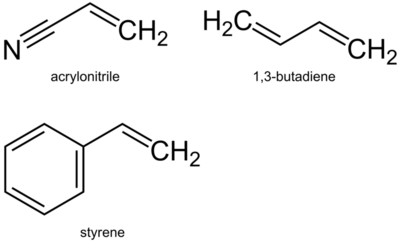 There are two plastics most commonly used in home 3D plastic extrusion printers: ABS and PLA. When you’re printing, you definitely notice them – or, your nose does.
There are two plastics most commonly used in home 3D plastic extrusion printers: ABS and PLA. When you’re printing, you definitely notice them – or, your nose does. PLA, also known as Polylactic acid or polylactide, has a rather pleasant aroma when heated, sometimes described as “waffles” or “honey”. Along with its lack of warping, the aroma makes for a very satisfactory 3D printing experience.
ABS, also known as Acrylonitrile butadiene styrene, with chemical formula: (C8H8)x· (C4H6)y·(C3H3N)z), has a very different printing experience, particularly when your 3D printer is poorly ventilated. Its smell is very sharp and sometimes can burn your throat if you breathe too much of it. Coughing can occur and we’ve often heard stories of folks with scratchy throats after a long ABS print operation. While ABS can warp during printing, it does produce strong models that can take a beating.
But is it killing you? What happens when you breathe it in? Is it poisonous? Does it cause cancer? We took a deeper look by examining its Material Safety Data Sheet, a document that must accompany any industrial substance. According to the MSDS:
Emergency Overview:Solid pellets with slight or no odor. Spilled plastics create slipping hazard. Can burn in a fire creating dense, toxic smoke. Molten plastic can cause severe thermal burns. Fumes produced during melt processing may cause eye, skin and respiratory tract irritation. Secondary operations, such as grinding, sanding or sawing, can produce dust which may present a respiratory hazard. Product in pellet form is unlikely to cause irritation.Chronic/Carcinogenicity:None of the components present in this material are listed by IARC, NTP, OSHA, or ACGIA as a carcinogen.
We also checked Wikipedia, which says:
ABS is flammable when it is exposed to high temperatures, such as a wood fire. It will melt then boil, at which point the vapors burst into intense, hot flames. Since pure ABS contains no halogens, its combustion does not typically produce any persistent organic pollutants, and the most toxic products of its combustion or pyrolysis are carbon monoxide and hydrogen cyanide.
There you have it: apparently ABS is (relatively) safe for 3D printing. Just don’t set your models on fire or sand them into a fine dust. We imagine you could poke yourself in the eye with a stray filament, too. Nevertheless, we think suitable ventilation is necessary, if only to remove the irritations.
Via PlasticsMadeSimple (PDF) and Wikipedia

